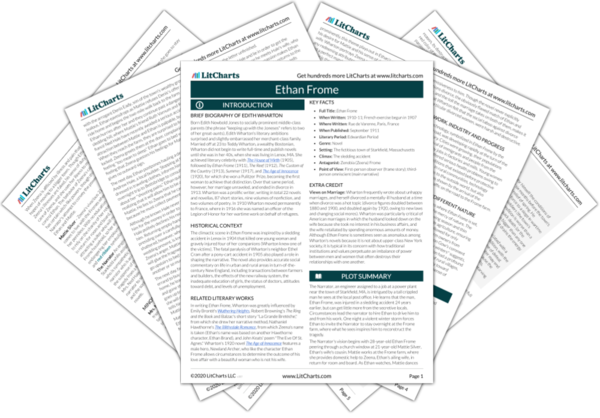Welcome to the LitCharts study guide on Edith Wharton's Ethan Frome. Created by the original team behind SparkNotes, LitCharts are the world's best literature guides.
Ethan Frome: Introduction
Ethan Frome: Plot Summary
Ethan Frome: Detailed Summary & Analysis
Ethan Frome: Themes
Ethan Frome: Quotes
Ethan Frome: Characters
Ethan Frome: Symbols
Ethan Frome: Literary Devices
Ethan Frome: Theme Wheel
Brief Biography of Edith Wharton

Historical Context of Ethan Frome
Other Books Related to Ethan Frome
- Full Title: Ethan Frome
- When Written: 1910-11; French exercise begun in 1907
- Where Written: Rue de Varenne, Paris, France
- When Published: September 1911
- Literary Period: Edwardian Period
- Genre: Novel
- Setting: The fictitious town of Starkfield, Massachusetts
- Climax: The sledding accident
- Antagonist: Zenobia (Zeena) Frome
- Point of View: First-person observer (frame story); third-person omniscient (main narrative)
Extra Credit for Ethan Frome
Views on Marriage: Wharton frequently wrote about unhappy marriages, and herself divorced a mentally-ill husband at a time when divorce was a hot topic (divorce figures doubled between 1880 and 1900, and doubled again by 1920, owing to new laws and changing social mores). Wharton was particularly critical of American marriages in which the husband looked down on the wife because she took no interest in his business affairs, and the wife retaliated by spending enormous amounts of money. Although Ethan Frome is sometimes seen as anomalous among Wharton's novels because it is not about upper-class New York society, it is typical in its concern with how traditional institutions and values perpetuate an imbalance of power between men and women that often destroys their relationships with one another.












